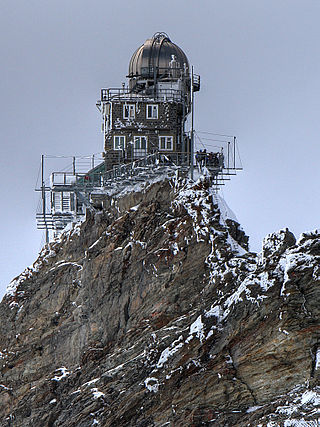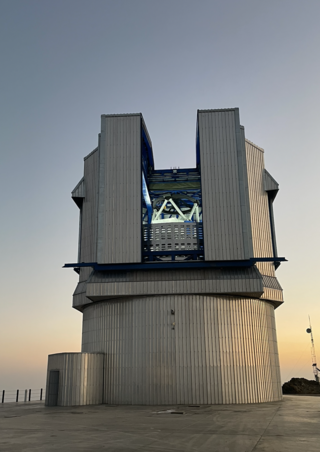
The Kitt Peak National Observatory (KPNO) is a United States astronomical observatory located on Kitt Peak of the Quinlan Mountains in the Arizona-Sonoran Desert on the Tohono Oʼodham Nation, 88 kilometers (55 mi) west-southwest of Tucson, Arizona. With more than twenty optical and two radio telescopes, it is one of the largest gatherings of astronomical instruments in the Earth's northern hemisphere.

An observatory is a location used for observing terrestrial, marine, or celestial events. Astronomy, climatology/meteorology, geophysics, oceanography and volcanology are examples of disciplines for which observatories have been constructed. Historically, observatories were as simple as containing an astronomical sextant or Stonehenge.

A Ritchey–Chrétien telescope is a specialized variant of the Cassegrain telescope that has a hyperbolic primary mirror and a hyperbolic secondary mirror designed to eliminate off-axis optical errors (coma). The RCT has a wider field of view free of optical errors compared to a more traditional reflecting telescope configuration. Since the mid 20th century, a majority of large professional research telescopes have been Ritchey–Chrétien configurations; some well-known examples are the Hubble Space Telescope, the Keck telescopes and the ESO Very Large Telescope.

The Mount Wilson Observatory (MWO) is an astronomical observatory in Los Angeles County, California, United States. The MWO is located on Mount Wilson, a 1,740-meter (5,710-foot) peak in the San Gabriel Mountains near Pasadena, northeast of Los Angeles.
The National Solar Observatory (NSO) is a United States federally funded research and development center to advance the knowledge of the physics of the Sun. NSO studies the Sun both as an astronomical object and as the dominant external influence on Earth. NSO is headquartered in Boulder and operates facilities at a number of locations - at the 4-meter Daniel K. Inouye Solar Telescope in the Haleakala Observatory on the island of Maui, at Sacramento Peak near Sunspot in New Mexico, and six sites around the world for the Global Oscillations Network Group one of which is shared with the Synoptic Optical Long-term Investigations of the Sun.
The Indian Astronomical Observatory (IAO) is a high-altitude astronomy station located in Hanle, India and operated by the Indian Institute of Astrophysics. Situated in the Western Himalayas at an elevation of 4,500 meters (14,764 ft), the IAO is one of the world's highest located sites for optical, infrared and gamma-ray telescopes. It is currently the tenth (see List of highest astronomical observatories) highest optical telescope in the world. It is India's first dark-sky preserve.

The Vainu Bappu Observatory is an astronomical observatory owned and operated by the Indian Institute of Astrophysics. It is located at Kavalur in the Javadi Hills, near Vaniyambadi in Tirupathur district in the Indian state of Tamil Nadu. It is 200 km south-west of Chennai and 175 km south-east of Bangalore.

Konkoly Observatory is an astronomical observatory located in Budapest, Hungary is part of the Research Centre for Astronomy and Earth Sciences and belongs to the Eötvös Loránd Kutatási Hálózat. It was founded in 1871 by Hungarian astronomer Miklós Konkoly-Thege (1842–1916) as a private observatory, and was donated to the state in 1899. Konkoly Observatory, officially known as ELKH CSFK Konkoly Thege Miklós Csillagászati Intézet in Hungarian, is the largest astronomical research institute in Hungary, and hosts the largest telescopes in the country. The Observatory has more than 60 researchers, a quarter of them are non-Hungarian.

A solar telescope is a special purpose telescope used to observe the Sun. Solar telescopes usually detect light with wavelengths in, or not far outside, the visible spectrum. Obsolete names for Sun telescopes include heliograph and photoheliograph.

Manali Kallat Vainu Bappu was an Indian astronomer and president of the International Astronomical Union. Bappu helped to establish several astronomical institutions in India, including the Vainu Bappu Observatory which is named after him, and he also contributed to the establishment of the modern Indian Institute of Astrophysics. In 1957, he discovered the Wilson–Bappu effect jointly with American astronomer Olin Chaddock Wilson.

The Shamakhy Astrophysical Observatory, named after Nasreddin Tusi of the National Academy of Sciences of Azerbaijan was established on November 17, 1959, by decree No. 975 of the Council of Ministers of the Azerbaijan SSR. ShAO operates as a research institute within the ANAS Department of Physical, Mathematical, and Technical Sciences. The Observatory is located in the north-east of the Greater Caucasus Range, 150 km from the city of Baku, in the eastern part of Mount Pirkuli, at an altitude of 1435–1500 m above sea level, in geographical coordinates λ = 48⁰ 35' 04" E, φ = 40⁰ 46 '20"N. Here the number of clear nights suitable for observation reaches 150-180 per year.

Leibniz Institute for Astrophysics Potsdam (AIP) is a German research institute. It is the successor of the Berlin Observatory founded in 1700 and of the Astrophysical Observatory Potsdam (AOP) founded in 1874. The latter was the world's first observatory to emphasize explicitly the research area of astrophysics. The AIP was founded in 1992, in a re-structuring following the German reunification.

The Mount Abu InfraRed Observatory (MIRO) is located near the town Mount Abu in the state of Rajasthan, India. The observatory is at an altitude of 1680 metres and is adjacent to Guru Shikhar, highest peak of the Aravalli Range. The 1.2 m infrared telescope at It is the first major facility in India specifically designed for ground-based, infrared observations of celestial objects. Further the low amount of precipitable water vapour at Guru Shikhar makes it a good site for the infrared telescope observations. The site has been found to be good for astronomical observations.

Aryabhatta Research Institute of Observational Sciences (ARIES) is a research institute in Nainital, Kumaon, India which specializes in astronomy, solar physics, astrophysics and atmospheric science. It is an autonomous body under the Department of Science and Technology, Government of India. The institute is situated at Manora Peak (elevation 1,951 m or 6,401 ft), about 9 kilometres (5.6 mi) from Nainital, headquarters of Kumaon division.
The National Large Solar Telescope (NLST) is a Gregorian multi-purpose open telescope proposed to be built in Merak village in Ladakh in India and aims to study the sun's microscopic structure.

The Institute for Astronomy, Astrophysics, Space Applications, and Remote Sensing is a non-profit research institute in Greece with expertise in multidisciplinary astrophysical, space and environmental sciences. It is an independent research Institute of the National Observatory of Athens (NOA) established in 2012 from the merging of the Institute of Astronomy and Astrophysics and the Institute of Space Applications and Remote Sensing. The scientists of the Institute have broad knowledge in various areas of observational Astrophysics, Space Science and Earth observation techniques and their applications. They have established collaborations with research groups in Europe and United States, and their work is recognized through publications in refereed journals, invited talks at international conferences, and coordination of EU-funded and ESA-funded research projects. More details on the IAASARS and its activities can be found in its annual report.

The 3.6m DevasthalOptical Telescope is a clear-aperture Ritchey–Chrétien telescope built by Aryabhatta Research Institute of Observational Sciences (ARIES) and is located at the Devasthal Observatory site near Nainital, Kumaon, India. ARIES operates another 1.3m telescope at the same location. The telescope was activated remotely on 31 March 2016 by Indian Prime Minister Narendra Modi and Belgian Prime Minister Charles Michel from Brussels. The telescope optics has been built in collaboration with the Belgian firm Advanced Mechanical and Optical System (AMOS).

Iranian National Observatory (INO) is an Iranian astronomical observatory inaugurated in 2021. It has reported the capture of its first light on 15 October 2022 upon the commissioning of the home-grown optical telescope with a primary mirror of 3.4 m, making it by far the country's largest astronomical research facility.
















